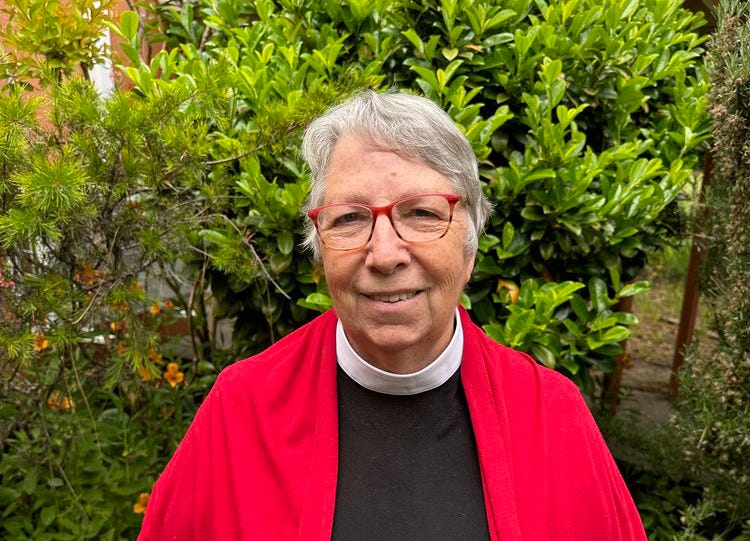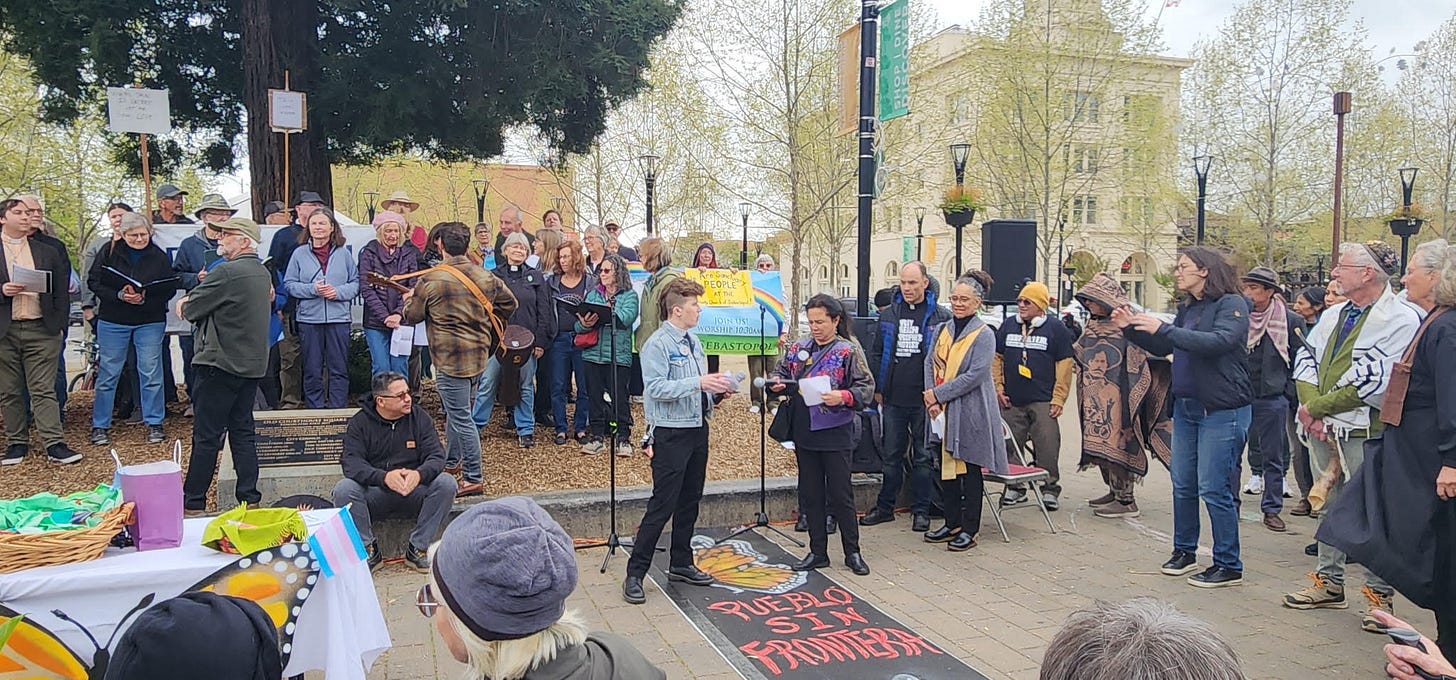The Community Church of Sebastopol embraces the role of "sanctuary church"
In response to the Trump administration's crackdown on immigration, the Community Church of Sebastopol becomes the first church in town to declare itself a "sanctuary church"

The concept of using a house of worship as a sanctuary is an old one—mentioned in ancient Mosaic law and formalized early in Christian history. In the early 1980s, a church sanctuary movement sprang up in the United States to provide safe haven for Central American refugees fleeing civil conflict in El Salvador and Guatemala. Now, with the Trump administration cracking down on immigration, some churches are once again declaring themselves “sanctuary churches.”
The Community Church of Sebastopol is thus far the only Sebastopol church to have officially declared itself a sanctuary church, though Saint Stephen’s Episcopal is considering doing so.
Last Wednesday, April 16, Broadbent of the Community Church and the Rev. Kate Sefton from St. Stephen’s and members of their congregations attended a rally and press conference of church leaders, congregation members, and immigrant community members announcing this new sanctuary movement.
The churches involved in the event included The Community Church of Sebastopol, St. Stephen's Episcopal Church, Christ Church United Methodist, Congregation Ner Shalom, Emmaus Community (Santa Rosa), First Congregational Church of Santa Rosa (UCC), Redwood Forest Friends, Unitarian Universalist Congregation of Santa Rosa, Unitarian Universalists of Petaluma and Windsor United Methodist Church.
The rally was organized by the North Bay Organizing Project Religious Leaders' Caucus and the Sonoma County Sanctuary Coalition.

“Our County must do everything we can to keep our neighbors safe,” Broadbent wrote in a press release for the event. “We invite more congregations to declare themselves ‘sanctuary’ so that our community is welcoming to migrants in both word and action.”
The Press Democrat reported that several hundred people attended the rally, a large turnout that surprised the organizers.
The Sebastopol Times sat down with Rev. Broadbent on Wednesday afternoon, just before the rally, to learn why the Community Church of Sebastopol had decided to become a sanctuary church.
Unsurprisingly, Broadbent said his support for the new sanctuary movement emerged from his religious faith.
“I mean, it’s pretty central to Christian faith that we are to serve the least among us, and we do that because Jesus spent time with and served the least among him that were around him. So that’s part of it. Part of it is the scriptures themselves say that you are to treat the foreigner in your land as if they were a neighbor and a citizen,” he said.
“There’s a passage in Leviticus that says you shall treat the alien as your neighbor,” he said. “There are other places in Isaiah where it says you shall invite the homeless poor into your home and then within the Christian faith, there are all kinds of references to Jesus providing hospitality to those who are not part of the inside group, but rather on the margins.”
The stranger who dwells among you shall be to you as one born among you, and you shall love him as yourself; for you were strangers in the land of Egypt: I am the LORD your God. (Leviticus 19:34)
Is not this the kind of fasting I have chosen: to loose the chains of injustice and untie the cords of the yoke, to set the oppressed free and break every yoke? Is it not to share your food with the hungry and to provide the poor wanderer with shelter—when you see the naked, to clothe them, and not to turn away from your own flesh and blood?”(Isaiah 58:6-7)
For I was hungry and you gave me food, I was thirsty and you gave me drink, I was a stranger and you welcomed me. (Matthew 25: 35)
Broadbent said his church voted as a whole to become a sanctuary church. “We had a congregational meeting. We kind of educated the congregation on it, and then we had a motion and a vote. It was resoundingly supportive,” he said.
What exactly does it mean to be a sanctuary church? Historically—and in the popular imagination—people physically sought sanctuary in church buildings. Broadbent said that isn’t necessarily the case these days.
“Growing up in the 80s, I remember that sanctuary movement. The church I grew up in in Santa Cruz hosted a family from El Salvador for a period of weeks. In this new sanctuary movement, that could be a possibility. For the time being, though, our church has decided that that’s not something we have the capacity to offer or think would be particularly helpful at this point,” he said, though he said some churches are considering this approach.
“Maybe part of the difference is that in the ’80s, there were people fleeing wars in Central America—frankly, that our country had a part in fomenting—and they were on the move. Whereas it’s much more the case that the people who are feeling most threatened generally are people who’ve been here for at least a little while and have already established and built a community and have some form of housing, so they're not passing through. And the other part is the Trump Administration changed some rules, which once designated as protected spaces churches, schools, libraries and hospitals, and they have now said that is not the case.”
Given that church buildings are no longer automatically safe spaces, Broadbent said housing immigrants in the church “might actually jeopardize people, because we can't claim that ICE can’t come in.”
Instead, Broadbent said they’ve had to learn new legal means of resistance.
“We’re also learning some things, like, churches are private spaces,” he said. “We have some flyers that say immigration agents are not allowed to enter without a warrant. And the warrant has to be a judicial warrant and not an ICE warrant. It has to be timely—I think it has about a seven-day period of time—and it has to specifically name somebody that they are looking for. It can’t be general, like, ‘We just want to search your area to see if we can find someone.’ And it can’t be something signed off simply by an ICE officer. It has to be signed by a federal immigration judge.”
If churches aren’t physically housing immigrants, what does “sanctuary” mean in practical terms?
“Here specifically, we want to stand in solidarity with people, which means showing up at events like the one that’s happening today [i.e., last Wednesday]. We also want to provide, potentially, accompaniment to people who may be vulnerable. That could mean a whole array of things. It could mean supporting a person or a family emotionally, spiritually, but also with referrals. Depending on the situation they’re in, it could mean providing some direct aid or helping them access resources that are available in the county.”
“Mainly we don’t want people to think that they're just all on their own and that people don’t care about them,” he said. “By becoming a sanctuary congregation, we’re saying, ‘No, we see you, we care about you.’ We want to live in a country and a society that values people across the spectrum and isn’t scapegoating certain groups of people, especially those who are scared and most vulnerable. We don’t want them to feel alone.”
This impulse is shared by Rev. Kate Sefton from St. Stephen’s Episcopal Church in Sebastopol, who also attended the rally last Wednesday with eight other members from that church. She said she went to represent St. Stephen’s, not as a sanctuary church, but “as a church which is inclusive, supportive and loving of our neighbors in all justice work.”

Sefton emphasized that St. Stephen’s has not declared itself a sanctuary church.
“We are having a conversation about sanctuary, what that might mean, what our work for immigration protection and legislation might mean,” she said.
For now, they’re working on other ways to support local immigrants.
“On Sunday afternoon, we had a fundraiser for Sonoma Secure Families Collaborative,” an immigration rights organization, “and we raised $5,000...And so we are doing that kind of support for that community without declaring ourselves or engaging yet in becoming a sanctuary church.”
“For me, showing up right now is to let people know that the interfaith movement is so very important, that religion at work is profoundly different from Christian Nationalism, and that as faith communities we must unite against religious bigotry and persecution,” Sefton said.
Back at the Community Church of Sebastopol, Broadbent hopes more churches in the area will do the kind of internal work required to become sanctuary churches. He said he found the process of becoming a sanctuary church extremely heartening.
“It’s particularly lovely to do this work as a congregation because there are lots of different kinds of people in our congregation, and they come at this from lots of different perspectives,” he said. “And so you’ve got people of a variety of ages and backgrounds, who don’t agree on every little thing about it, but they do agree that we should be a humane society, we should be caring for our neighbors, and that the current actions of the current administration seem to have crossed all kinds of lines of morality. So we feel like it’s our role as a church to say, ‘No, we need to stand up for morality. We need to stand up for values. We need to stand up for love and hospitality.’ And that’s what we’re doing.”




So GLAD to see our local places of worship acting from their religious values.